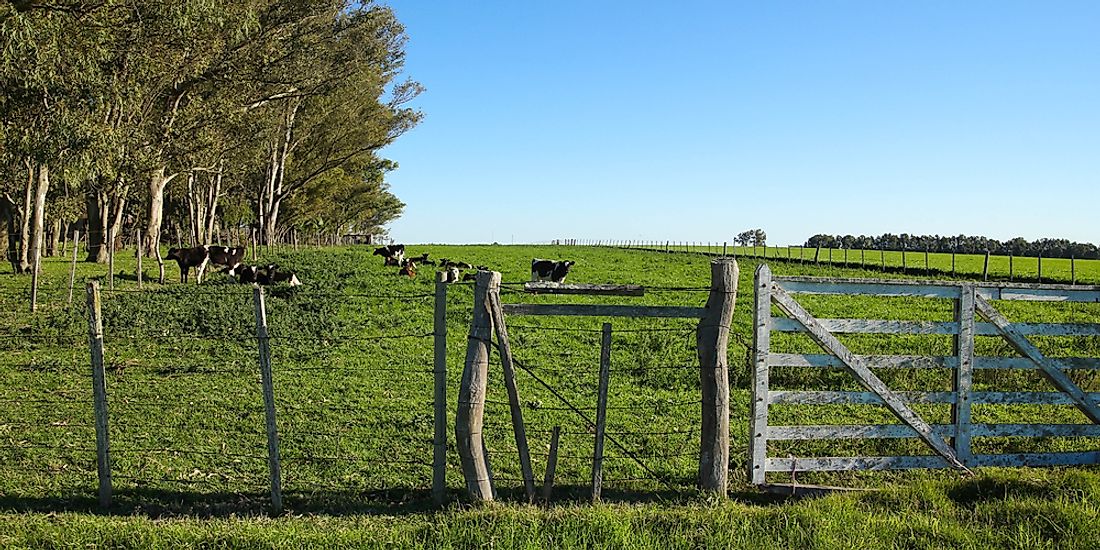What Are The Major Natural Resources Of Uruguay?

Uruguay is South America’s second smallest nation after Suriname. The country has an area of 68,000 square miles with a population of 3.44 million people out of which 1.8 million reside in the metropolitan area of the capital city, which is also the largest city in the country, Montevideo. The country has an export-oriented economy which is characterized by high levels social spending, highly educated labor force, and the agricultural sector playing a significant role in the economy. Some of the natural resources in Uruguay include arable land, minerals, fish, beautiful scenery, and hydropower, among many others.
Arable Land
Uruguay has an arable land which accounts for about 10.1% of the total land area according to the estimates as of 2011. By 2015, the arable land in Uruguay had increased to reach 13.8% of the total land area, but in 1990 the share of the arable land was at its lowest standing at 7.1%, and it has been increasing gradually ever since. The top agricultural items, particularly for the export market in Uruguay, include wool and beef. In 1991, Uruguay joined the MERCUSOR agreement, and its exports of beef increased significantly as it was able to reach more markets in other countries like Japan. However, the export of wool has not been doing so well in the recent past and has seen competition from other countries like New Zealand. Similarly, there have been fluctuations in demand particularly during the recession of 2008-2009. Agriculture is still playing an important role in Uruguay and accounts for about 10% of the country's GDP and it is the principal earner of foreign exchange putting Uruguay on the same level with other major agricultural exporters like Canada, Brazil, and New Zealand.
Livestock
In the year 2000, Uruguay exported livestock worth approximately $1 billion, and they were primarily livestock products such as beef, chicken, veal, horse, duck, lamb, goose, pork, and turkey among others. As of 1999, there was approximately 10.5 million heads of cattle in the country and approximately 14.4 million sheep. However, in 1999, there was a breakout of foot-and-mouth disease in the country, and many countries placed a ban on all livestock products from Uruguay. By 2000 the country had eradicated the disease, and the export of livestock products increased again, where beef was the largest export of livestock products which accounted for 58.6%. Israel was the leading export destination for beef products originating from Uruguay and it took 25.09% of exports.
Fish
Fish farming in Uruguay is one of the vibrant sectors in the country and employs approximately 12,000 people. The country has numerous stocks of fish species, and fishing accounts for only 0.1% of the country's GDP. The fishing industry has numerous challenges that include pollution. For instance, in 1977 there was an oil spill on the coastal resort of Punta del Este by an Argentinean ship san Jorge, which significantly affected fish stocks in the coastal area. The incident affected about 20 miles along the coast and almost had a disastrous effect on fish species like sea lions. Presently, hake accounts for 70% of the fish caught in the coastal region followed by Crocker which accounts for 14% and the striped white fish account for 5%. Currently, the country is investigating the possibility of developing the industry to include deep water fish species such as squid, swordfish, and anchovy. Besides the fishing for commercial purposes, there is sports fishing and some of the fish hunted for sport include Black Corvinas, White Corvinas, Soles, Sargos, Brótolas, Pescadillas, Groupers, Pejereyes, Anchoas, and Burriquetas.
Minerals
Mining in Uruguay contributes about 0.1% of the nation's GDP, and some of the minerals mined in the country include semi-precious gemstones, clay, iron, gold, sand, steel, gravel, and stone among others. The sector does not contribute significantly to the economy of Uruguay, but in the recent past, there has been more activity particularly in the production of gold, cement, and extraction of granite in the country. The Uruguay Mineral Exploration Inc (UME) was the only Canadian company involved in gold production in Uruguay. The company manages San Gregorio gold mine, and in 2009 it produced about 54,320 troy ounces of gold, while in 2009 the company produced about 90,668 troy ounces of gold. The drop in production was attributed to heavy rainfall and the lower grade of gold in the mine. Cement is also produced in the country.
Tourism In Uruguay
In Uruguay, tourism plays an important role in the economy and the country has developed different tourist destination across the country which include Piriapolis, Punta del Este, Rivera, Artigas, Lavalleja, Montevideo, Salto, Rocha, and Colonia del Sacramento among others. In 2007 there were approximately 1.8 million visitors who arrived in the country who spent approximately $800 million which was a significant increase from the year 2006. Beaches and hotels around the Punta del Este attract a large number of visitors both local and international. The increase in a number of tourists has driven the rise in building and construction boom in the region.











